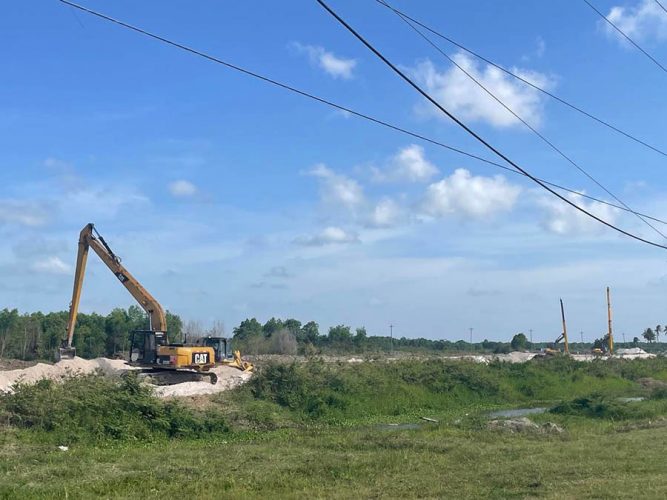With the railway embankment being upgraded to accommodate four lanes of traffic, the design of the East Coast-East Bank Demerara bypass road project is being modified to include the changes, Minister of Public Works Juan Edghill said.
“We have some issues to resolve. For example, when we designed the road it was supposed to connect with a two-lane road at the railway embankment but it’s now connecting with a four-lane. They have to be able to put in the necessary features to make sure there is a smooth connection…,” Edghill said.
The minister recently conducted a site visit to observe the quality and progression of work. The visit, with his team of engineers, was to give him a first-hand understanding of how the changes in the design will be incorporated.

The thoroughfare is being constructed from the intersection of the Ogle Airstrip Road and the Rupert Craig Highway, East Coast Demerara to Haags Bosch, Eccles, East Bank Demerara.
Additionally, Edghill explained that they are also working to relocate utility poles between the railway embankment and the Rupert Craig Highway.
During a visit to the worksite at the Ogle end of the project, Stabroek News observed that land clearing for the new thoroughfare has been completed and the contractor, India-based Ashoka BuildCon, has started to backfill the route with sand. The Department of Public Information (DPI) reported that the contractor, with guidance from the consulting firms RITES Limited in association with CB & Associates Inc, has completed clearing the site from a stretch of 2.3 kilometres, with a width of 120 metres on the main alignment.
A base layer of white sand materials, 500 millimetres thick, has been filled in over a portion of the path, and another portion spans 0.31 kilometres over the full width of the path. Prefabricated Vertical Drains (PVDs) are being installed to improve the ground condition of the path that spans 0.57 kilometres and another section that spans 0.27 kilometres, along the main alignment, the DPI report said. PVDs, a geotechnical engineering method, are vertical columns made of plastic or other synthetic materials, which are installed into the ground to improve soft and compressible soils.
“I had the opportunity to be briefed by the consulting firm and they are quite pleased… and I am quite satisfied with the work being done,” Edghill stated.

The project, a brainchild of the PPP/C government, is being realised by way of a loan agreement with the Indian Government following a visit by former president Donald Ramotar. The loan is from the Indian Exim Bank.
In June last year a contract was signed with Ashoka BuildCon for the construction of the road to the tune of US$106.3 million. While the government will be accessing a US$50 million line of credit from the Indian Exim Bank it has to come up with the remainder.
Minister within the Ministry of Public Works Deodat Indar at the contract signing said that the project would see the construction of a 7.8-kilometre, four-lane road, with each lane being 3.6 metres wide. In addition to a median, the road will also feature sidewalks and supporting structures. Another feature of the road will be a connector to the Eccles access road.
Construction of the road was expected to commence by August at the end of the rainy period, Ashoka BuildCon Director Ashish Kataria had said on the day of the contract signing. Though the project is scheduled to be completed in 24 months, the contractor was challenged to do so before the stipulated deadline.

This will be the first major project for the company in Guyana and Kataria said they are assessing future opportunities here in the emerging infrastructural and oil and gas sectors.
Government also signed a US$3.2 million with another Indian company, RITES Limited, which is providing supervisory and consultation services during the construction of the road.
According to Ashoka’s website, the company is a full-service contractor and industry leader, with the expertise to execute any scale of project within a limited time span. It boasts over 35 years of experience with some of India’s most challenging and complex projects.






